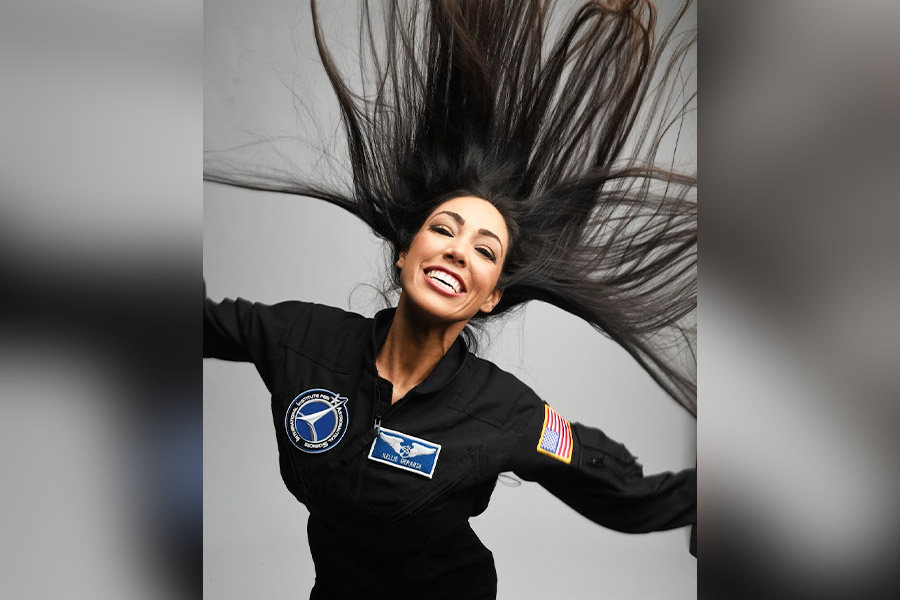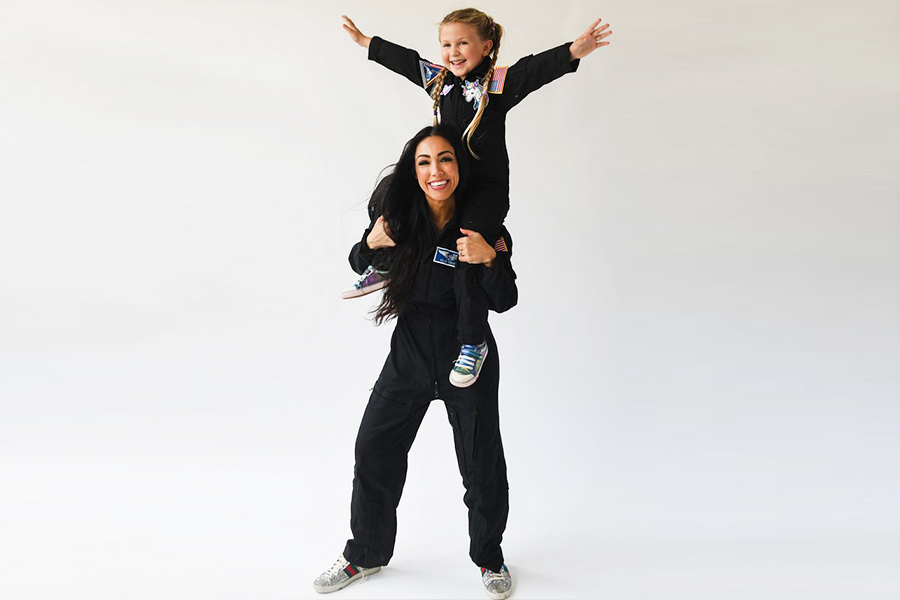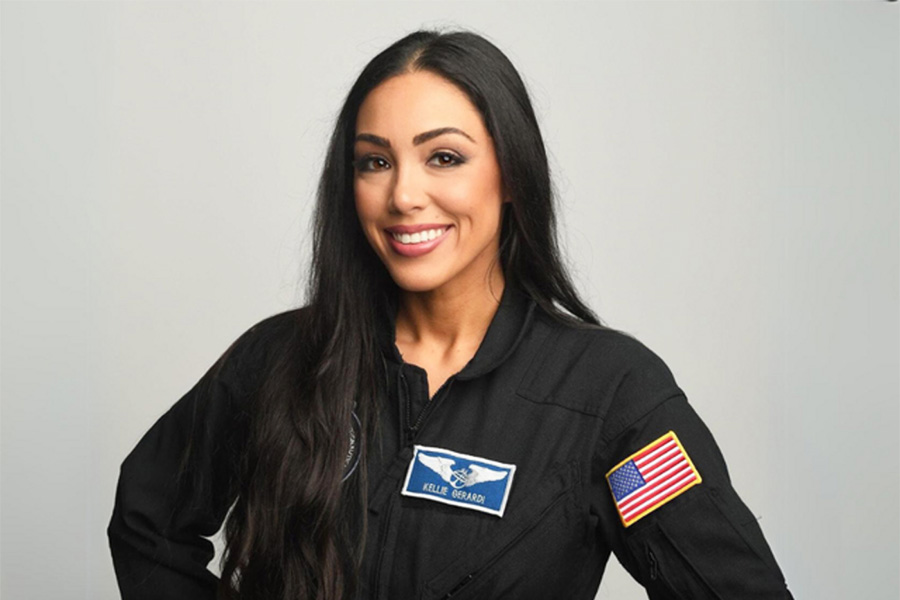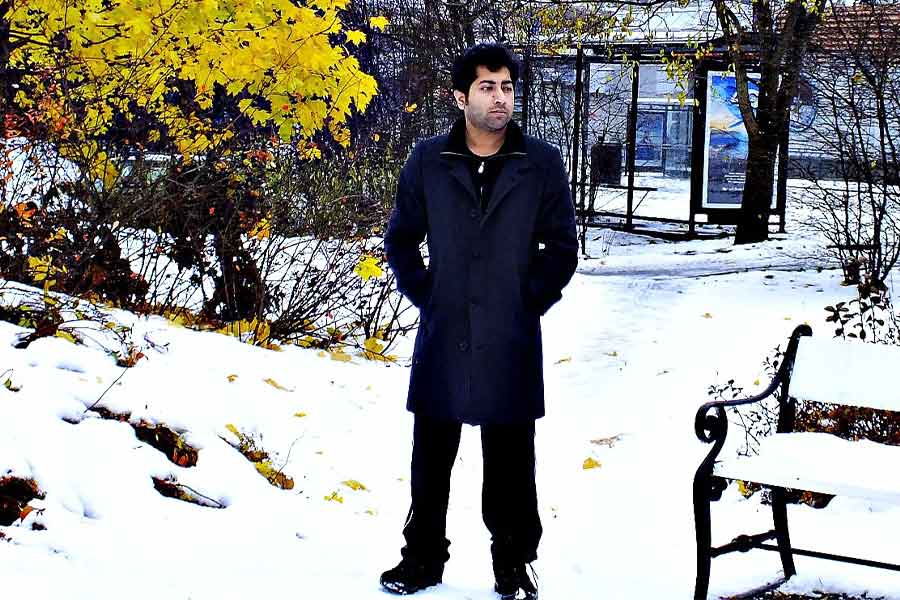Kellie Gerardi — astronaut, researcher, author and mom — is among the first 100 women to be in space. In 2023, Gerardi flew as a payload specialist on the Galactic 05 research mission, during which she conducted biomedical and thermodynamic fluids experiments on behalf of the International Institute for Astronautical Sciences (IIAS). Gerardi’s second spaceflight, in 2026, will witness her leading an all-female research crew aboard Virgin Galactic’s new Delta class spacecraft.
Following her first foray into space, Gerardi has made it her mission to enable a new generation of scientists to use space as a laboratory, inspiring women to embrace their multitudes, and showing her daughter’s generation that even the sky is no limit. With millions of followers on social media platforms, Gerardi is also the author of the acclaimed children’s book series Luna Muna. Currently based in Jupiter, Florida, Gerardi spoke to The Telegraph Online on her remarkable journey, becoming an author, providing an example for her daughter, and more.
‘Space was the standout passion of mine, but it was always a much bigger dream than just flying’

Gerardi has worked relentlessly to open up access to space for a new generation of researchers Kellie Gerardi
TTO: What made you want to be an astronaut? Who were your biggest supporters?
Kellie Gerardi: Where to begin! I grew up in Jupiter, Florida, and I always had great exposure to human spaceflight. Space shuttles were a part of the backdrop of my childhood and adolescence. Space was the standout passion of mine, but it was always a much bigger dream than just flying. My goal was to help open up access to space for a new generation of researchers. My eventual career path led me to work on space policy, regulatory reform, reusable rocket technology, defence and national security and, ultimately, microgravity research with the IIAS.
We’ve spent years conducting parabolic flight research campaigns on Earth along with the National Research Council of Canada and the Canadian Space Agency. But our goal has always been to send our researchers to space, where our experiments can benefit from longer-duration microgravity exposure. My career is full of people and organisations who bet on me, and that serves as the motivation to work as hard as I can to make sure those bets pay off.
What was your first space flight experience like? Is the ‘Overview Effect’ (a cognitive shift felt by some astronauts when viewing Earth from space) real?
I felt incredibly well-trained and knew exactly what to expect during my spaceflight, but nothing could have truly prepared me for seeing Earth with my own eyes. I was in absolute awe. We’ve all seen pictures of the Earth from space, but the difference for me was truly experiencing it as a planet among other planets. I’ll never forget it. Looking down, I experienced an intense cognitive dissonance of feeling both a part of it and slightly outside of it. It was mind-bending and profound. If I’m honest, I’m still processing it. So, yes, I would say the ‘Overview Effect’ is definitely real, and is truly a cognitive shift in perspective.
‘In 2026, I’ll be leading a research crew on another dedicated science mission with Virgin Galactic’
What are you expecting from your next spaceflight? What research will you be doing onboard?
As a payload specialist, my job is to operate experiments and conduct scientific research in space on behalf of my research institute. In 2026, I’ll be leading a research crew on another dedicated science mission with Virgin Galactic, who will once again transform the cabin of their spaceship into a science lab.
On my first mission, I operated biomedical and fluid experiments and we were thrilled with the data — so this next mission is an opportunity to expand on that research. For example, I previously validated a theory about how fluids behave in a container in microgravity. Now that we’ve demonstrated our ability to accurately predict this behaviour, on this next spaceflight I want to demonstrate our ability to control it as well. This data can be used to help inform new designs for technologies, ranging from spacecraft life support systems to new syringes for medication in space. I’m also excited for the opportunity to introduce new biomedical research — one of my crewmates is a physician and space medicine expert, so she’ll have us pretty task-loaded with healthcare experiments!
‘‘Luna Muna’ has been read from the International Space Station and the White House’

An excerpt from ‘Luna Muna’, published in February 2022 Amazon
Tell us about the Luna Muna series. What was your goal with writing the children’s book series?
Luna Muna started off as a bedtime story that I’d tell my daughter. Around the same time, I was also noticing a market gap for space-themed books that centred around girls as the main characters. I wrote the series as an effort to fill that gap. The sparkly future astronaut Luna Muna, with her glittery space helmet, helped create some visual representation in the minds of young girls to show that space, sparkle, glitter and science can all go together! I’ve been so humbled by the reception. Luna Muna has been read from the International Space Station and was also selected to be read from the White House as part of the First Lady’s Reading Nook during the President’s annual Easter Egg Roll, which was a tremendous honour.
‘The most rewarding aspect of my own journey has definitely been experiencing it through the eyes of my daughter’

Gerardi with her daughter Delta Kellie Gerardi
How do you want to create more hope for your daughter Delta?
I’m grateful for all the female trailblazers in the world who are reshaping access and opportunity for the next generation while also embracing their multitudes. The most rewarding aspect of my own journey has definitely been experiencing it through the eyes of Delta, my six-year-old daughter. We’ve had fewer than 100 female astronauts, but in Delta’s mind, flying to space is just another thing girls do! She is growing up knowing that not even the sky’s the limit for her dreams. It’s also been a powerful reminder of how much can change in a single generation. When my mom was born, human beings hadn’t yet been to space. And when she was growing up, women weren’t eligible. Just one generation later, she watched her daughter reach the stars and watched her granddaughter take it for granted. It’s a paradigm shift, and I’m filled with excitement for Delta’s generation.
‘I like to share my life with mission-driven younger women’
Since you have a lot of young women and moms among your fans, what are some tips you want to offer for balancing work and family life?
When you have big career dreams and you also want a family, there’s no “right time” to have both. It’s all a balancing act. Discovering I was pregnant with my daughter was the most wonderful surprise, but there were definitely adjustments. I missed microgravity flight campaigns and aerobatic flights while pregnant, and shortly after her birth, I was wearing Spanx under my flight suit just to keep my organs in the right place. I have a true partner in my husband, but over the years, there were definitely difficult times. We actually moved back to my hometown a few years ago to be closer to my parents because I needed more childcare help. Was there the occasional mom guilt? Sure. But becoming Delta’s mom made my dreams burn brighter and my sense of purpose grow so much deeper. I like to share my life with mission-driven younger women who are made to second-guess if they can make a career and family work together, or moms made to feel guilty on the days when those scales don’t balance — you have to tune it all out.
Lastly, what is the most misunderstood aspect of space travel?
I think there has historically been an assumption that there’s only one singular path to space. While that may have been true in the past, the emergence of the commercial spaceflight industry has helped usher in a new era of human spaceflight. My career as a researcher and payload specialist on a commercial spacecraft is just one of many examples of a myriad of new paths.











